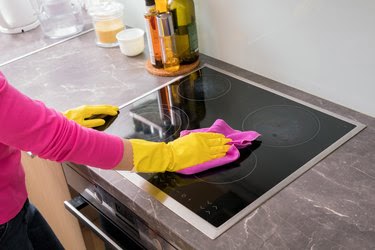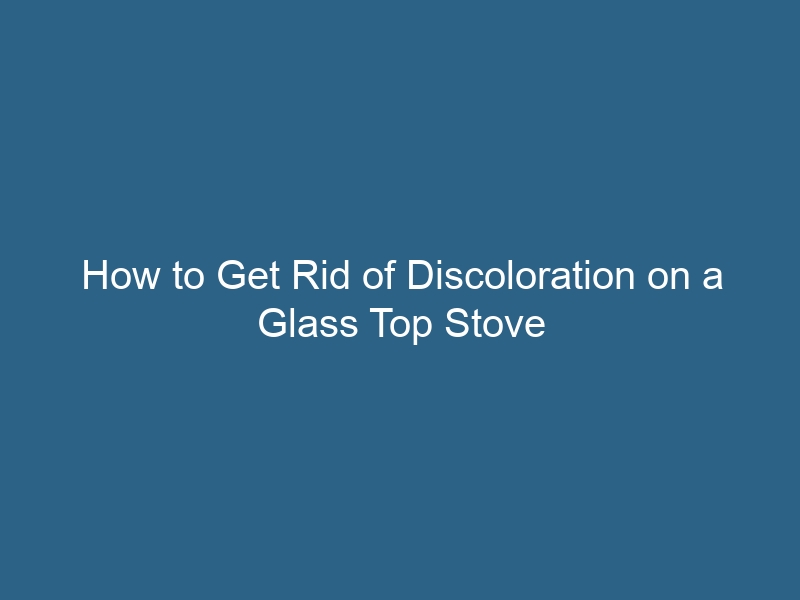Quck answer
To remove discoloration from a glass top stove, follow these steps:
1. Clean the stove: Start by wiping down the entire surface of the stove with a damp cloth or sponge to remove any loose dirt or debris.
2. Make a cleaning solution: Mix equal parts of vinegar and water in a spray bottle. Vinegar is a natural cleaner that can help remove stains and discoloration.
3. Spray and scrub: Spray the cleaning solution onto the discolored areas of the stove and let it sit for a few minutes. Then, use a non-abrasive sponge or cloth to gently scrub the stains in a circular motion.
4. Rinse and dry: Once the stains are removed, rinse the stove with clean water and wipe it dry with a clean cloth.
5. Prevent future discoloration: To prevent future discoloration, avoid using abrasive cleaners or scrub brushes on the glass top stove. Instead, regularly clean the surface with mild soap and water or a vinegar-water solution.
By following these steps, you can effectively remove discoloration from a glass top stove and keep it looking clean and shiny.
Glass stove tops are smooth and prevent the accumulation of dirt and grease that is common in the areas under burners on regular stoves. However, they are not completely resistant to mess. Discoloration can occur due to hot items, spilled food, or using the wrong cleaning products, which can dull the shiny surface. Fortunately, there are simple and cooktop-safe cleaners that can restore the stove’s shine.

Baking Soda Scrub
A paste made from baking soda can help remove certain types of discoloration, such as rings caused by hot pots or pans. Mix several tablespoons of baking soda with a small amount of water to form a paste. Then, apply the paste over the entire stain. Cover the paste with a hot, damp dishcloth that won’t bleed dye onto the cooktop. After 30 minutes, use the cloth to wipe away the baking soda. Rinse the cloth and wipe the surface again. If the stain persists, cover it with dry baking soda and add enough vinegar to make the powder foam. After a minute or two, clean the area with a microfiber cloth.
The Vinegar First Method
Vinegar is a natural cleaner that is great for everyday stove maintenance. It can also remove white or chalky discolorations caused by minerals in water. Spritz the entire glass surface with vinegar and let it sit for a few seconds, then wipe it down with a soft white cloth. If the glass looks clean, you’re done. If not, sprinkle baking soda over the stained areas and any residue stuck to the stove top. Soak a soft hand towel in warm water, wring out most of the water, and place it over the cooktop. After 15 minutes, use the towel to rub the glass. Rinse the towel regularly as it absorbs baking soda. Finally, buff the glass with vinegar and a fresh soft cloth.
Specialized Cleaner
A cleaning solution specifically designed for glass cooktops can also remove discolored areas. Apply a few drops of the cleaner to the stove top, follow the cleaner’s directions for how long to let it sit, and then buff the stains with a soft white cloth. Rinse the cloth and wipe the cooktop to remove any remaining residue. If necessary, apply the cleaner directly to stubborn stains and let it sit a little longer before wiping it up.
Avoid Ammonia and Harsh Cleaners
Although it may seem fine to use a regular glass cleaner on glass stove tops, some of these products can actually cause temporary discoloration. Many window-cleaning sprays contain ammonia, which leaves iridescent marks on glass stoves when the burners heat up. To remove these marks, spray them with vinegar and wipe with a soft cloth.
In addition, avoid using harsh cleansers, as they can do more than temporarily discolor the glass. Cleansers like powders used to scrub porcelain tubs can create very fine scratches on the cooktop surface, gradually dulling the glass over time.


